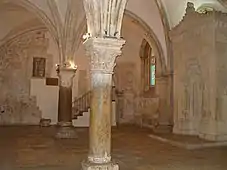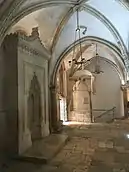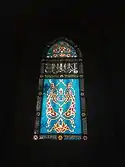Cenacle
Cenacle (from Latin cēnāculum#Latin "dining room", later spelt coenaculum), also known as the "Upper Room" (from Koine Greek anagaion and hyperōion, both meaning "upper room") was the first Christian church according to Catholics.[1] Other denominations believe the first church is the Church of Saint Peter. It is a room in the David's Tomb Compound in Jerusalem, and was traditionally held to be the site of the Last Supper.


The language in Acts suggests that the apostles used the room as a temporary residence (Koine Greek: οὗ ἦσαν καταμένοντες, hou ēsan katamenontes),[2] although the Jamieson-Fausset-Brown Bible Commentary disagrees, preferring to see the room as a place where they were "not lodged, but had for their place of rendezvous".[3]
In Christian tradition, the room was not only the site of the Last Supper (i.e. the Cenacle), but the room in which the Holy Spirit alighted upon the eleven apostles on Pentecost. It is sometimes thought to be the place where the apostles stayed in Jerusalem.
Etymology
"Cenacle" is a derivative of the Latin word cēnō, which means "I dine". Jerome used the Latin coenaculum for both Greek words in his Latin Vulgate translation.
"Upper room" is derived from the Gospel of Mark and the Gospel of Luke, which both employ the Koine Greek: αναγαιον, anagaion, (Mark 14:15 and Luke 22:12), whereas the Acts of the Apostles uses Koine Greek: ύπερωιον, hyperōion (Acts 1:13), both with the meaning "upper room".
Overview

The Cenacle is considered the site where many other events described in the New Testament took place,[4][5] such as:
- preparation for the celebration of Jesus' final Passover meal[6]
- the washing of his disciples' feet [7]
- certain resurrection appearances of Jesus [8][9][10]
- the gathering of the disciples after the Ascension of Jesus[11]
- the election of Saint Matthias as apostle[12]
- the descent of the Holy Spirit upon the disciples on the day of Pentecost.[13]
Pilgrims to Jerusalem report visiting a structure on Mount Zion commemorating the Last Supper since the fourth century AD. Some scholars would have it that this was the Cenacle, in fact a synagogue from an earlier time. The anonymous pilgrim from Bordeaux, France reported seeing such a synagogue in 333 AD. A Christian synagogue is mentioned in the apocryphal fourth-century Anaphora Pilati ("Report of Pilate"). But a Jewish origin for the building has come under serious question for which see below. The building has experienced numerous cycles of destruction and reconstruction, culminating in the Gothic structure which stands today.
While the term "Cenacle" refers only to the Upper Room, a niche located on the lower level of the same building is associated by tradition with the burial site of King David, marked by a large cenotaph-sarcophagus first reported seen by 12th-century Crusaders but earlier mentioned in the 10th-century Vita Constantini.[14] Most accept the notice in 1 Kings 2:10[15] that says David was buried "in the City of David", identified as the eastern hill of ancient Jerusalem, as opposed to what is today called Mount Sion, which is the western hill of the ancient city. The general location of the Cenacle is also associated with that of the house where the Virgin Mary lived among the Apostles until her death or dormition, an event celebrated in the nearby Church of the Dormition.
History

The early history of the Cenacle site is uncertain; scholars have attempted to establish a chronology based on archaeological, artistic and historical sources.[16]
Based on the survey conducted by Jacob Pinkerfeld in 1948,[17] Pixner believes that the original building was a synagogue later probably used by Jewish Christians. However, no architectural features associated with early synagogues such as columns, benches, or other accoutrements are present in the lower Tomb chamber.[18] According to Epiphanius, bishop of Salamis writing towards the end of the 4th century, the building and its environs were spared during the destruction of Jerusalem under Titus (AD 70).[19] Pixner suggests that the Mount Zion site was destroyed and rebuilt in the later first century.[20] The lowest courses of ashlars (building stones) along the north, east and south walls are attributed by Pinkerfeld to the late Roman period (135-325 AD).[21] Pixner believes that they are Herodian-period ashlars, dating the construction of the building to an earlier period.[22] Many scholars, however, date the walls' earliest construction to the Byzantine period and identify the Cenacle as the remains of a no-longer-extant Hagia Sion ("Holy Zion") basilica.[23] The Roman emperor Theodosius I constructed the five-aisled Hagia Sion basilica likely between 379 and 381 AD.[24]
Sixth-century artistic representations, such as the mosaics found in Madaba, Jordan (the "Madaba Map") and the Basilica of Santa Maria Maggiore in Rome, depict a smaller structure to the south of basilica. Some have identified this smaller structure as the Cenacle thus demonstrating its independence from, and possible prior existence to, the basilica.[25] The basilica (and the Cenacle?) was later damaged by Persian invaders in 614 AD but restored by the patriarch Modestus. In AD 1009 the church was destroyed by the Muslim caliph Al-Hakim. Shortly afterward it was replaced by the Crusaders with a cathedral named for Saint Mary featuring a central nave and two side aisles. The Cenacle was either repaired or enclosed by the Crusader church, occupying a portion of two aisles on the right (southern) side of the altar.[26] The Crusader cathedral was destroyed soon afterward, in the late 12th or early 13th century, but the Cenacle remained. (Today, part of the site upon which the Byzantine and Crusader churches stood is believed to be occupied by the smaller Church of the Dormition and its associated Abbey.)
Syrian Christians maintained the Cenacle until the 1330s when it passed into the custody of the Franciscan Order of Friars who managed the structure until 1524. At that time Ottoman authorities took possession of the Cenacle converting it into a mosque. The Franciscans were evicted from their surrounding buildings in 1550. Architectural evidence remains of the period of Muslim control including the elaborate mihrab in the Last Supper room, the Arabic inscriptions on its walls, the qubba over the stairwell, and the minaret and dome atop the roof. Christians were not allowed to return until the establishment of the State of Israel in 1948. The historical building is currently managed by the State of Israel Ministry of the Interior.
Architecture



.jpg.webp)

Scholars offer wide-ranging dates and builders for the surviving Gothic-style Cenacle. Some believe that it was constructed by Crusaders just before Saladin’s conquest of Jerusalem in 1187, while others attribute it to Holy Roman Emperor Frederick II, after he arrived in the city in 1229. Still others hold that it was not built in this form until the Franciscans acquired the site in the 1330s.[29] Scarce documentation and disturbed structural features offer little strong support for any of these dates.[30]
Archaeology
The primary early modern assessments of the Cenacle were recorded by French archaeologists. The first detailed assessment was by Eugène-Melchior de Vogüé in 1860.[31] This was largely followed by other commentators until the work of Camille Enlart[32] and Louis-Hugues Vincent / Félix-Marie Abel.[33][34]
Capitals and columns
In its current state, the Cenacle is divided into six rib-vaulted bays. The bays are supported by three freestanding columns which bilaterally divide the space, as well as six pillars flanking the side walls. While the capital of the westernmost freestanding column is flush with the Cenacle’s interior wall, the column shaft itself is completely independent of the wall, leading scholars to consider the possibility that this wall was not original to the building.[35]
An analysis of the column and pillar capitals offers clues, but not a solution, to the mystery of the current building’s origin. The Corinthianesque capital between the second and third bays of the Cenacle is stylistically indicative of multiple geographical regions and chronological periods. This capital’s spiky leaves, which tightly adhere to the volume of the column before erupting into scrolls, are in congruence with common outputs of the 12th century sculpture workshop at the Temple site in Jerusalem in the last years before Saladin’s conquest in 1187.[36] The workshop also frequently utilized drilling as an ornamental device. The Jerusalem workshop included artists from diverse regions in the West, who brought stylistic traits with them from their native countries. The workshop produced sculpture for many Crusader projects and other structures, such as the al-Aqsa mosque.
This comparison allows for the support of the 12th century date of the Cenacle. There are also, however, similar capitals which originated in workshops in southern Italy, a draw for scholars who wish to associate the building with Holy Roman Emperor Frederick II and the Sixth Crusade in 1229. Examples can be seen in the Romanesque cathedral in Bitonto, a small city near Bari, in southern Italy, and on column supports of the pulpit in the Pisa Baptistery, carved by Apulian-born sculptor Nicola Pisano around 1260.
The capitals of the freestanding columns are not identical. The capital between the first and second bays seems either severely weathered or shallowly carved, and its volume is a marked contrast from the others. It rises from the shaft in a straight cylinder, rather than in an inverted pyramid, and then flares only just before it intersects with the abacus. The third capital, which now flanks the Cenacle’s western wall, is also unique among the three. It is not decorated with a floral motif, rather, scrolling crockets spring from the base of the volume. Enlart has proposed a comparison to buildings constructed by Frederick II in Apulia.[37]
Analysis of these column capitals does not yield significant evidence to link them to the 14th century and a potential Franciscan construction, nor does it definitively date them to the 12th or 13th century. The building remains a frustrating, but intriguing, mystery.
References in hymns
The upper room is a focus or reference in several Christian hymns, for example in "An upper room did our Lord prepare", written by Fred Pratt Green in 1973,[38] and in "Come, risen Lord, and deign to be our guest" ('We meet, as in that upper room they met...'),[39] written by George Wallace Briggs.
See also
- Church of Zion, Jerusalem or Church of the Apostles on Mount Zion, Roman-era church or synagogue speculated to have belonged to an early Jewish-Christian congregation
Other sites
St. Mark’s Monastery in the Old City of Jerusalem near the Armenian Quarter is sometime considered as alternative place for the cenacle. The monastery church, belonging to the Syriac Orthodox Church, contains an early Christian stone inscription testifying to reverence for the spot.[40]
References
- Fortescue, A. (1910). "Jerusalem (A.D. 71-1099)". In The Catholic Encyclopedia. New York: Robert Appleton Company. Retrieved January 26, 2020 from New Advent. "During the first Christian centuries the church at this place was the centre of Christianity in Jerusalem, "Holy and glorious Sion, mother of all churches" (Intercession in "St. James' Liturgy", ed. Brightman, p. 54). Certainly no spot in Christendom can be more venerable than the place of the Last Supper, which became the first Christian church."
- Cambridge Bible for Schools and Colleges on Acts 1, accessed 24 September 2016: "The eleven were the tenants of the upper room, to which the other disciples resorted for conference and communion".
- Jamieson-Fausset-Brown Bible Commentary on Acts 1, accessed 24 September 2016
- "The Cenacle". Franciscan Custody of the Holy Land. Archived from the original on 2008-09-15. Retrieved 20 June 2009.
- "The Coenaculum". www.goisrael.com. Israel Ministry of Tourism. Archived from the original on 2009-06-21. Retrieved 20 June 2009.
- Luke 22:13
- John 13:4–11
- Mark 16:14
- Luke 24:33
- John 20:19
- Acts 1:13
- Acts 1:15
- Acts 2:1–4
- Vita Constantini 11.
- 1 Kings 2:10
- For example: Bargil Pixner, "The Church of the Apostles found on Mount Zion," Biblical Archaeology Review 16.3 May/June 1990 (http://www.centuryone.org/apostles.html Archived 2018-03-09 at the Wayback Machine); David Christian Clausen, The Upper Room and Tomb of David: The History, Art and Archaeology of the Cenacle on Mount Zion (Jefferson, NC: McFarland, 2016).
- Jacob Pinkerfeld, "'David's Tomb': Notes on the History of the Building: Preliminary Report," Bulletin of the Louis Rabinowitz Fund for the Exploration of Ancient Synagogues 3, ed. Michael Avi-Yonah (Jerusalem: Hebrew University, 1960): 41-43.
- Clausen, 168-175
- Epiphanius, On Weights and Measures 14 (54c).
- Bargil Pixner, Paths of the Messiah and Sites of the Early Church from Galilee to Jerusalem: Jesus and Jewish Christianity in Light of Archaeological Discoveries, ed. Rainer Riesner, trans. Keith Myrick and Sam and Miriam Randall (San Francisco: Ignatius Press, 2010), 332-3.
- Pinkerfeld, Notes.
- Pixner, Paths 333.
- Joan Taylor, Christians and the Holy Places: The Myth of Jewish-Christian Origins (Oxford: Clarendon Press, 1993), 215; Oskar Skarsaune, In the Shadow of the Temple: Jewish Influences on Early Christianity (Downers Grove, IL: InterVarsity Press, 2002), 189; Denys Pringle, The Churches of the Crusader Kingdom of Jerusalem: A Corpus, Vol. 3, The City of Jerusalem (New York: Cambridge University Press, 2007), 272.
- David Christian Clausen, The Upper Room and Tomb of David: The History, Art and Archaeology of the Cenacle on Mount Zion (Jefferson , NC: McFarland, 2016), 36.
- Pixner, Paths 349; Clausen, 49; Richard Mackowski, Jerusalem - City of Jesus: An Exploration of the Traditions, Writings, and Remains of the Holy City from the Time of Christ (Grand Rapids: Eerdmans, 1980), 146.
- Pringle 262
- DÜŞÜNCE VE TARİH, August 2016, Dr. Mehmet TÜTÜNCÜ, "Kudüs ve Sultan I. Süleyman"; Also at
- Mehmet Tütüncü (2006). Turkish Jerusalem (1516-1917): Ottoman Inscriptions from Jerusalem and Other Palestinian Cities. SOTA. p. 33. ISBN 978-90-807403-4-1.
In the name of Allah, the Compassionate the merciful. The order to purify and to cleanse of polytheists from this place and to make (here) a mosque so that the name of Allah is celebrated in it, is by the Sultan of mankind, the defender of Islamic faith, the servant of the sacred house (at Mecca), the establisher of Justice and security, the Sultan, son of Sultan, the Sultan Süleyman son of the House of Osman, may Allah support him throughout his life, by the hand of our Master leader of our Sheikhs, al Shams Muhammed al-‘ajami the preacher, may Allah carry out blessings through his hands and have mercy upon his parents, on the day of Thursday at the beginning of the month of Rebiulevvel in the year 930 and praise to be Allah alone.
- Hugh Plommer has written in favor of a date prior to 1187. See "The Cenacle on Mount Sion" in Crusader Art in the Twelfth Century, edited by Jaroslav Folda (Oxford: B.A.R., 1982) pp. 139–166. Camille Enlart supports a date after 1229. See Les monuments des croisés dans le royaume de Jérusalem; architecture religieuse et civile (Paris: P. Geuthner, 1925). Peter Fergusson believes that the structure dates from the 12th century but was heavily modified by the Franciscans in the 14th century. See "The Refectory at Easby Abbey: Form and Iconography." In The Art Bulletin, Vol. 71, No. 3 (Sep., 1989), pp. 334–351. The Franciscans themselves take credit for the building. See Fr. Eugene Hoade, Guide to the Holy Land (Jerusalem: Franciscan Printing Press, 1971).
- Pilgrimage accounts are vague. See the accounts of Daniel the Abbot and John of Wuerzburg in Jerusalem Pilgrimage 1099–1185, edited by John Wilkinson, Joyce Hill, and William H. Ryan (London: Hakluyt Society, 1988). Each describes the Cenacle simply as an "upper room" with no precise architectural consideration.
- Melchior marquis de Vogüé (1860). Les églises de la Terre Sainte. Librairie de Victor Didron. p. 322.
- New Discoveries in the Cenacle: Reassessing the Art, Architecture and Chronology of the Crusader Basilica on Mount Sion, Ilya Berkovich and Amit Reem
- Plommer 169
- See Zehava Jacoby, "The Workshop of the Temple Area in Jerusalem in the Twelfth Century: its Origin, Evolution, and Impact", Zeitschrift für Kunstgeschichte, 45 Bd., H. 4 (1982), 325–394. Drilling is discussed on p. 362.
- Enlart 258.
- "An Upper Room Did Our Lord Prepare". Hymnary.org.
- "Come, Risen Lord, and Deign to be Our Guest". Hymnary.org.
- "Saint Mark's Syrian Orthodox Church". www.goisrael.com. Israel Ministry of Tourism. Archived from the original on 26 December 2008. Retrieved 20 June 2009.
Further reading
External links
| Look up cenacle in Wiktionary, the free dictionary. |
| Wikimedia Commons has media related to Cenacle (Jerusalem). |
- "Church of the Apostles found on Mt. Zion" – article from the May/June 1990 issue of Biblical Archaeological Review
- The Judeo-Christian Synagogue and the Tomb of David
- The Development of the Judeo-Christian Synagogue
